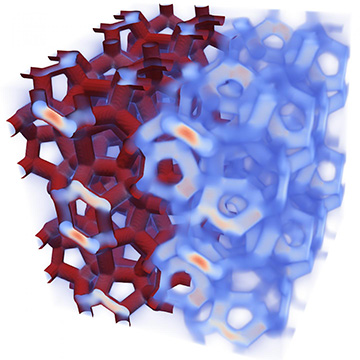
Researchers at Princeton University, USA, found that a type of foam can selectively block light, opening up the prospect for semiconductor-like photonic applications. This image is a computer model of the foam, showing the energy density of light as it passes through the foam. [Image: courtesy of the researchers (Klatt et al.)]
The word “foam” usually indicates the head atop a pint of Guinness or soap bubbles in a baby’s bath. But multidisciplinary researchers at Princeton University, USA, view the term differently: as a means of manipulating light (Proc. Natl. Acad. Sci., doi: 10.1073/pnas.1912730116).
A team headed by chemistry professor Salvatore Torquota has shown that a particular type of foam can block certain wavelengths of light. That capability offers potential for use in next-generation information technology based on photons rather than electrons.
Unnatural foams
The research involved computer simulations of the structure of Weaire-Phelan (WP) foam. Designed and developed by Irish physicist Denis Weaire and his student Robert Phelan, this is an ordered arrangement of foam whose individual components possess the minimum possible surface area.
WP foam doesn’t exist naturally. But Weaire’s group and others have made them in the laboratory, in liquid and solid varieties. The design also formed the outer wall of the aquatics center at the 2008 Olympic Games in Beijing.
A foamy band gap
The Princeton team, which included physicist Paul Steinhardt and postdoctoral researcher Michael Klatt, undertook what Torquato describes as “the first study of the optical properties of WP structures.” Computer simulations revealed that the foams allow some frequencies of light to pass through them while reflecting other frequencies, thereby blocking their passage.
This selective blocking, the team reports in the new work, resembles that of semiconductors. In both cases the process involves a band gap; the gap in the WP foam controls the flow of photons rather than electrons. “We knew that the WP structures possessed certain topological and geometrical properties that could enable them to open up photonic band gaps,” Torquato says. “But there was no guarantee that they would do so.”
Optics versus electronics?
Neither Torquato nor Weaire sees immediate applications for the finding. However, Torquato notes specific advantages of WP foams, such as their elastic and transport properties, that could enable optical rather than electronic solutions for next-generation technologies. “I am not aware of any attempt to use this trick for more bubbles,” Weaire adds. “But who knows?”
